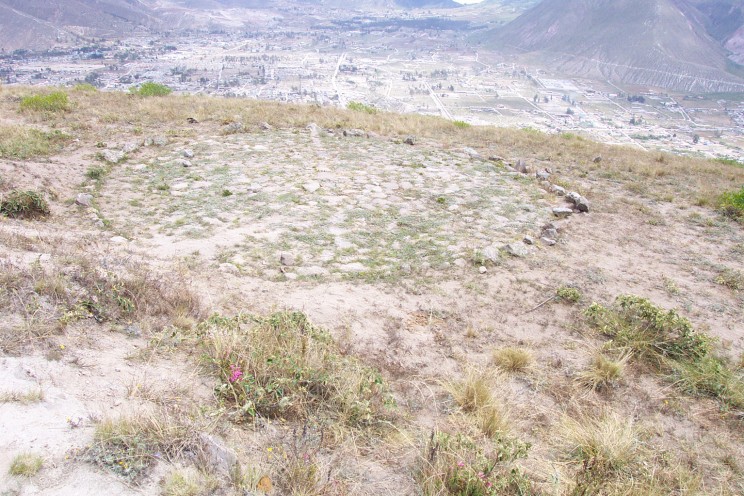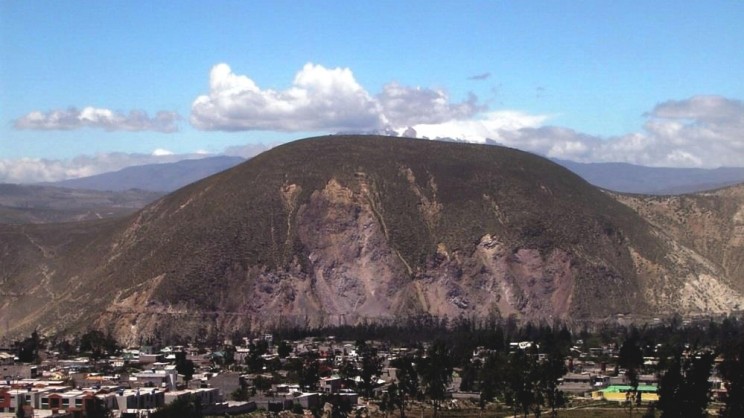On 12 August 2014 at precisely 2:58 a.m., a 5.1 earthquake struck, centered at the hilltop lightning huaca San Catequilla de Pichincha. Since this initial earthquake, there have been 57 aftershocks, all centered at or close to this hill. Cerro Catequilla is situated where the Río Monjas empties into the Río Guayllabamba, approximately 15 kilometers north of Quito in the Pomasqui Valley directly east of the town of San Antonio. This is the only known Inca huaca located directly under the equator at 0°0’02″ S by 78°25’43″ W at 2,683 meters above sea level, making this the paradigmatic place of the astral positioning. The southern terminus of the summit is situated directly on the Mitad del Mundo at the equator, 0º0’00” S, beside a series of natural springs. The mountains surrounding Cerro Cetquilla range from 3,000 to 4,000 meters above sea level and the Cerro Pululagua volcano is located due west.

Volcanoes have symbolic associations to lightning and the importance of this valley is evidenced by the two branches of the Inca road, or Camino Real, one to the east and the other to the west side of the hill. Numerous Inca sites are in the surrounding landscape, including Pucara de Rumicucho, an Inca fortress and administrative center. The lightning huaca is made up of two superimposed earthen platforms; a buried rectangular platform measuring about 100 meters N/S and about 80 meters E/W, below a large circular earthen platform measuring 60 meters in diameter. The locations of these superimposed platforms on the southwestern slopes of Cerro Catequilla are the only places on the 200-meter long hilltop where the equator is directly overhead. This is one of three Inca huacas with Catequilla toponyms between the equator and 3° N. Catequilla de Pichincha was the most highly venerated because of its location under the equator.
In 1609, the chronicler Garcilaso de la Vega stated that the pillars and columns on many platforms around Quito and to the north in Cayambe and Ibarra were “broken to pieces” by the Conquistador Sebastián de Benalcázar, who tore them all down because the Andeans worshiped them idolatrously. There is very little information in the Spanish chronicles or from the Audiencia de Quito on how temporal cycles were recorded in and around Quito during the Contact Period. Most scholars have found astronomical calculation regarding the solar calendar was achieved through shadow casting. The most highly venerated gnome was Catequilla de Pichincha, primarily because when the sun was overhead during certain parts of the annual cycle there was increasingly diminished shadow around the pillar or gnome at this lightning huaca.

The Inca constructed over a hundred ceremonial platforms and shrines (villcas), some on mountain passes (apachitas), others on the summits of the highest mountains in their empire, between 1438 and the Spanish Conquest in 1532. Lightning was the major theophany of weather in Inca religion, known as Ilapa, now Illapa, the Hispanic spelling. Huacas with “Catequil” or “Catequilla” toponyms were associated with the spread of Catequil, a religious cult to lightning throughout their empire. Lightning veneration extended from Quito to Cuzco during the early Colonial Period. The principal huaca associated with lightning, was another hilltop huaca in northern highland Peru, Catequil de Huamacucho, a huaca said to make other huacas “speak,” and therefore believed to have the ability to predict earthquakes. Spirits associated with lightning are malevolent, have ancient origins in Andean cosmology and religion, and are symbolically depicted in various cultural traditions.
Many lightning huacas around the equator and regions to the north have circular stone enclosures or platforms which local Andean informants have said to me are places where lightning struck and are therefore sanctified. Such features have also been identified archaeologically in and around the nearby Inca fortress at Pucara de Rumicucho. Circular stone enclosures or platform features generally measure between three to four meters in diameter and are dispersed throughout this region. However, these were not destroyed by the Spanish conquistadores because they were not venerated in an “idolatrous” manner. Some are located in indigenous towns in the surrounding valley and those in the nearby towns are clearly visible from the summit of Cerro Catequilla. My preliminary research at this site indicates that such features also had astronomical function in association with sight lines to the surrounding horizon, solar cycles, and constellations in the night sky. In the Andes, thunder and lightning have symbolic associations with rain, hail, earthquakes, and the metallurgical arts, particularly gold and silver, agricultural fertility, and fire and damaging hail storms.
Featured image: Andean landscape, north of Quito. This photo is looking north across Cerro Catequilla and was taken from the lightning huaca at 0°.00 latitude. This valley has historically been of critical importance to cultivation, transport, and the movement people and food crops into northern Ecuador and Colombia. Photo by John E. Staller.
The post Earthquake at the lightning huaca of San Catequilla de Pichincha appeared first on OUPblog.




